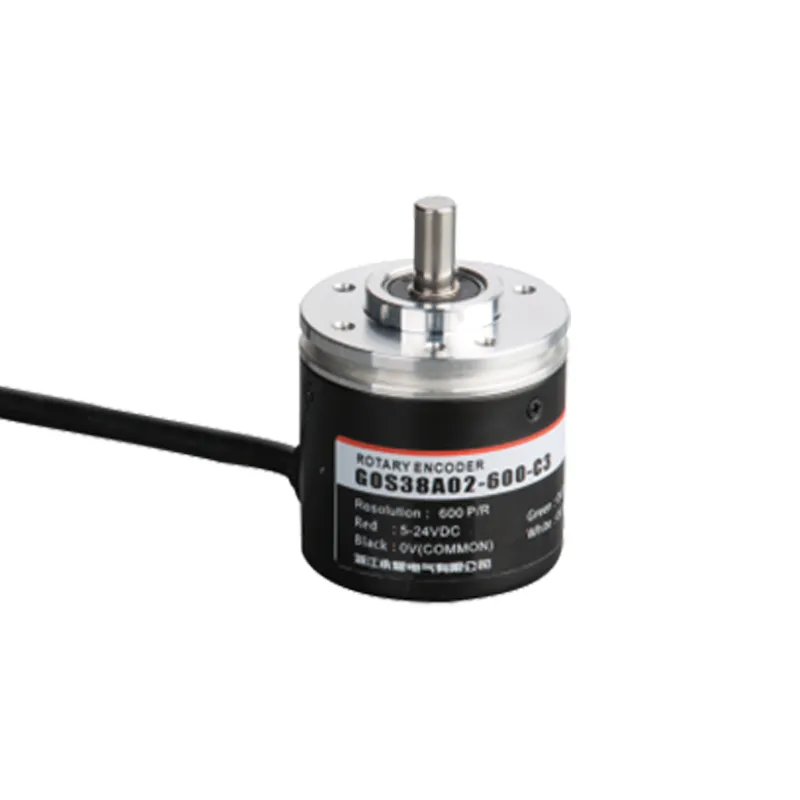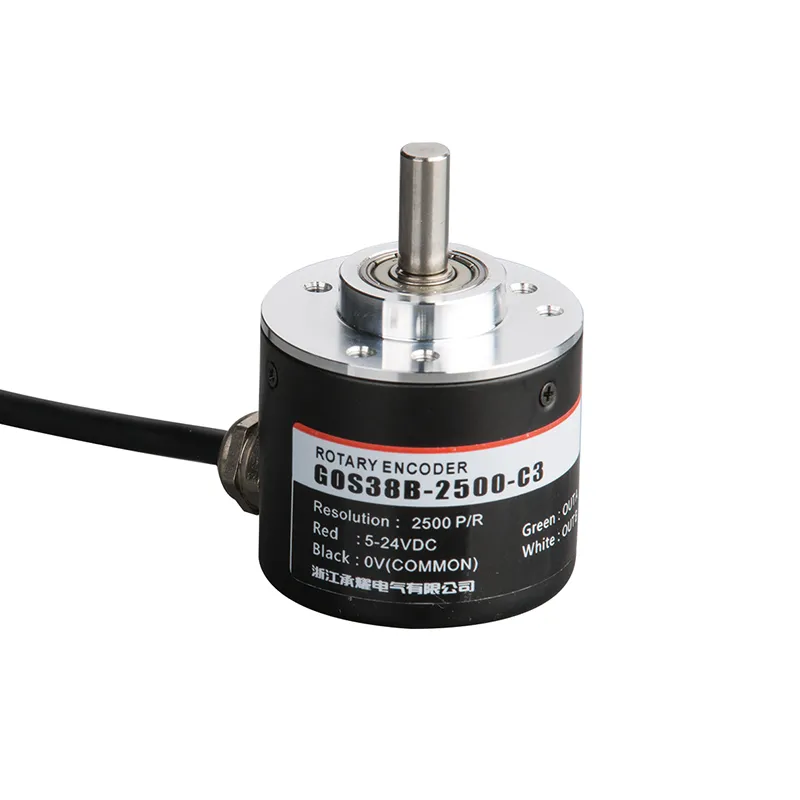Un codificador rotatorio es un sensor electromecánico que detecta y convierte la posición angular o el movimiento de un eje giratorio en señales eléctricas, ya sean impulsos digitales o tensiones analógicas. Estas señales transmiten información sobre la velocidad, posición y dirección del eje, lo que permite a los sistemas de control supervisar y ajustar con precisión el funcionamiento de la máquina.
Si alguna vez ha trabajado con maquinaria automatizada o robótica, es probable que se haya encontrado con un codificador rotatorio. Estos dispositivos son esenciales para medir la rotación, la posición y la velocidad en innumerables sistemas mecánicos. Ya sea en automatización industrial, máquinas CNC o motores eléctricos, los codificadores rotatorios proporcionan la información precisa necesaria para un control eficaz.
Un codificador rotatorio convierte el movimiento de rotación en señales eléctricas, lo que permite a las máquinas controlar con precisión la posición y la velocidad del eje. Exploremos el funcionamiento, las aplicaciones y las características fundamentales de los encóderes rotativos para ayudarle a elegir el que mejor se adapte a sus necesidades.
¿Qué es un codificador rotatorio?
Un codificador rotatorio es un sensor electromecánico que detecta y convierte la posición angular o el movimiento de un eje giratorio en señales eléctricas, ya sean impulsos digitales o tensiones analógicas. Estas señales transmiten información sobre la velocidad, posición y dirección del eje, lo que permite a los sistemas de control supervisar y ajustar con precisión el funcionamiento de la máquina.
Los codificadores rotatorios son los "ojos" de los sistemas automatizados modernos. Permiten la retroalimentación en tiempo real, esencial para el control de bucle cerrado en robótica, maquinaria industrial y accionamientos de motor. La palabra clave "codificador rotatorio" es muy buscada porque es un componente fundamental para el control de movimiento de precisión.
¿Cómo funciona un codificador rotatorio?
En el corazón de un codificador rotatorio hay un disco giratorio conectado al eje. Este disco tiene patrones -a menudo marcas ópticas o polos magnéticos- que interactúan con los sensores. A medida que el disco gira, los sensores detectan los cambios y los convierten en señales eléctricas.
Los codificadores ópticos utilizan una fuente de luz LED que brilla a través de ranuras en el disco.
Los codificadores magnéticos utilizan sensores de efecto Hall para detectar las variaciones del campo magnético.
Estas señales se convierten en ondas cuadradas, procedentes normalmente de dos canales denominados A y B, desfasadas 90° en fase. Este desfase permite al sistema determinar tanto la velocidad como el sentido de giro. Algunos encóderes también disponen de un canal Z o de índice que genera un único impulso por revolución, útil para establecer una posición de referencia.
| Canal | Propósito | Descripción |
|---|---|---|
| A | Salida de impulsos primaria | Detecta incrementos rotacionales |
| B | Señal de cuadratura para dirección | Determina el sentido de giro por desplazamiento de fase |
| Z | Pulso índice (opcional) | Un impulso por revolución como referencia |
Especificaciones principales del codificador rotatorio
Al seleccionar un codificador rotatorio, es importante comprender estas especificaciones principales:
| Parámetro | Descripción | Valores típicos |
|---|---|---|
| Resolución | Impulsos o posiciones por revolución del eje | De 100 a 5000+ (más alto = detalles más finos) |
| Tipo de salida de señal | Estilo de salida eléctrica | TTL, HTL, Colector abierto |
| Tensión de alimentación | Requisitos de potencia | 3,3V, 5V, 10-30V CC |
| RPM máximas | Velocidad máxima de rotación del eje | Hasta 12.000 o más |
| Protección (IP) | Resistencia al polvo/agua | IP54 a IP67 para condiciones duras |
| Temperatura de funcionamiento | Temperatura adecuada | Normalmente de -40 °C a +85 °C |
Consejo: En entornos difíciles, elija encóderes con la clasificación IP adecuada para prolongar la vida útil y la fiabilidad.
Aplicaciones del codificador rotatorio
Los codificadores rotatorios se utilizan ampliamente en todos los sectores industriales para supervisar y controlar la velocidad de rotación, la posición y la dirección:
Automatización industrial: Se utiliza en máquinas CNC, brazos robóticos, líneas de envasado y sistemas transportadores para un control preciso del movimiento.
Control del motor: Proporciona información sobre la velocidad y la posición del motor en ascensores, vehículos eléctricos y bombas.
Robótica: Fundamental para la detección de la posición de articulaciones y ruedas, lo que permite movimientos suaves y precisos del robot.
Productos sanitarios: Permite un posicionamiento preciso en sistemas de imagen y robots quirúrgicos.
| Industria | Ejemplo de aplicación | ¿Por qué un codificador rotatorio? |
|---|---|---|
| Fabricación | Máquinas CNC, robots | Información precisa y fiable |
| Automoción | Sensores de velocidad de las ruedas | Rendimiento rápido y robusto |
| Energías renovables | Controles de aerogeneradores | Información de velocidad duradera y precisa |
| Médico | Máquinas de diagnóstico | Precisión y repetibilidad |
Si su aplicación necesita una realimentación de movimiento fiable, los codificadores rotatorios son fundamentales. No dude en ponerse en contacto con nosotros para obtener asesoramiento y soluciones personalizadas.
Cómo elegir el codificador rotatorio adecuado
Seleccionar el codificador rotatorio ideal requiere tener en cuenta múltiples factores:
Necesidades de resolución: Una resolución más alta proporciona detalles más precisos de la posición, mientras que una resolución más baja es suficiente para obtener información sobre la velocidad.
Compatibilidad de ejes: Compruebe el diámetro del eje y el tipo de montaje para una integración perfecta.
Entorno operativo: Considere la clasificación IP para la protección contra el polvo, la humedad y las temperaturas extremas.
Requisitos de la señal de salida: Asegúrese de que el tipo de señal (TTL, HTL) es compatible con su sistema de control.
Durabilidad mecánica: Elija rodamientos y materiales adecuados para una mayor duración y un rendimiento constante.
Presupuesto y marca: Equilibre el coste con la fiabilidad del producto y la asistencia posventa.
| Factor de selección | Consideración | Ejemplos de opciones |
|---|---|---|
| Resolución | Precisión frente a necesidad de aplicación | 500 PPR a 4000 PPR |
| Grado de protección | Condiciones medioambientales | IP54 (estándar) a IP67 (impermeable) |
| Señal de salida | Compatibilidad de mandos | TTL, HTL |
| Diámetro del eje | Ajuste y estilo de montaje | Ejes macizos o huecos de 6 mm |
| RPM máx. | Capacidades de velocidad | Hasta 10.000 RPM |
¿No está seguro de lo que más le conviene? Póngase en contacto con nosotros para hablar de sus necesidades específicas: ¡nuestros expertos están preparados para ayudarle!
Tipos de codificadores rotativos: Incremental vs Absoluto
Una clasificación popular de los codificadores rotatorios se basa en su tipo de realimentación:
| Característica | Codificador incremental | Codificador absoluto |
|---|---|---|
| Salida | Señales de impulsos (movimiento relativo) | Código digital único por posición (absoluto) |
| Seguimiento de la posición | Requiere impulso de referencia para restablecer la posición | La posición se mantiene incluso tras una pérdida de potencia |
| Complejidad y coste | Más sencillo y económico | Más complejo y caro |
| Aplicaciones | Control de velocidad, control de posición básico | Posicionamiento de alta precisión, robótica |
Los encóderes incrementales ofrecen una retroalimentación rentable cuando la posición relativa es suficiente, mientras que los encóderes absolutos proporcionan datos de posición instantáneos y resistentes a las pérdidas de potencia.
Los encóderes giratorios son componentes vitales para obtener información precisa y fiable sobre velocidad, posición y dirección en numerosas aplicaciones industriales y comerciales. Conocer los tipos, principios de funcionamiento y especificaciones clave le ayudará a seleccionar el encóder adecuado para su tarea.
Tanto si automatiza maquinaria como si optimiza motores o diseña robots, un encóder rotativo bien elegido mejora la precisión y la eficacia. ¿Está listo para encontrar el encóder perfecto? Póngase en contacto con nosotros hoy mismo para obtener asesoramiento profesional, soluciones personalizadas y precios competitivos.
PREGUNTAS FRECUENTES
¿Cuál es la resolución máxima de un codificador rotatorio?
Los codificadores rotativos comerciales típicos oscilan entre 100 PPR y varios miles de impulsos por revolución.
¿Cómo detectan la dirección los codificadores rotatorios?
Comparando la fase entre dos canales de salida, se puede determinar con precisión la dirección.
¿Cuánto duran los codificadores rotatorios?
Los codificadores de alta calidad pueden durar millones de revoluciones y muchos años en condiciones normales de funcionamiento.
¿Pueden utilizarse los codificadores rotatorios al aire libre o en zonas polvorientas?
Sí, seleccionando encóderes con grados de protección IP adecuados (IP65 o superior), pueden funcionar de forma fiable en entornos difíciles.
¿Cómo se conectan los codificadores rotatorios a los sistemas de control?
Normalmente, las señales de salida se conectan a entradas de PLC o microcontrolador configuradas para el recuento de impulsos.
¿Qué es mejor: un encóder incremental o absoluto?
Depende de si su aplicación necesita datos de posición acumulada o de posición absoluta instantánea y de las consideraciones presupuestarias.


